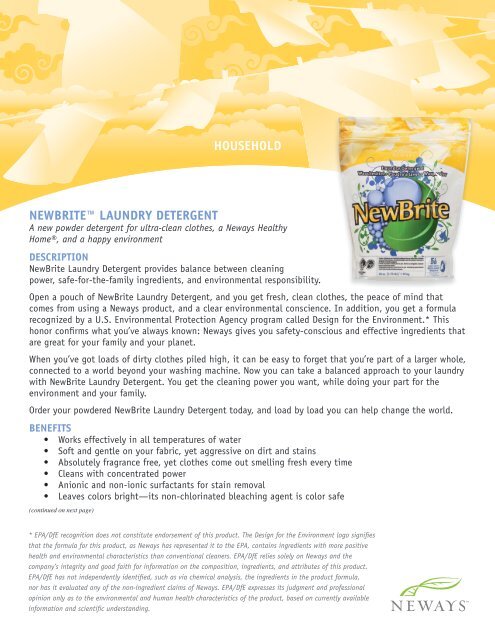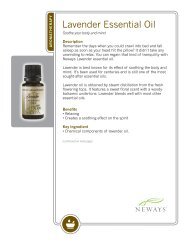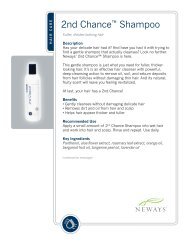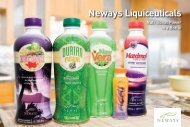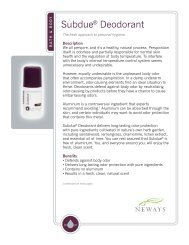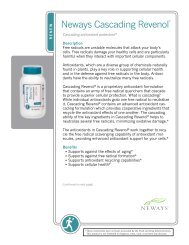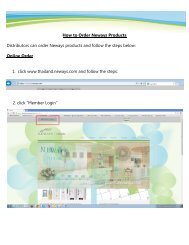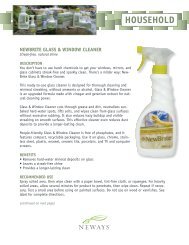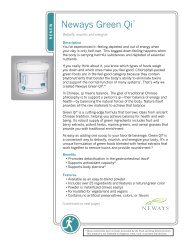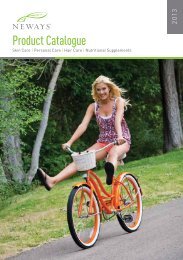HOUSEHOLD NEwBritE⢠LaUNDry DEtErgENt
HOUSEHOLD NEwBritE⢠LaUNDry DEtErgENt
HOUSEHOLD NEwBritE⢠LaUNDry DEtErgENt
You also want an ePaper? Increase the reach of your titles
YUMPU automatically turns print PDFs into web optimized ePapers that Google loves.
<strong>HOUSEHOLD</strong><br />
NewBrite Laundry Detergent<br />
A new powder detergent for ultra-clean clothes, a Neways Healthy<br />
Home®, and a happy environment<br />
DESCRIPTION<br />
NewBrite Laundry Detergent provides balance between cleaning<br />
power, safe-for-the-family ingredients, and environmental responsibility.<br />
Open a pouch of NewBrite Laundry Detergent, and you get fresh, clean clothes, the peace of mind that<br />
comes from using a Neways product, and a clear environmental conscience. In addition, you get a formula<br />
recognized by a U.S. Environmental Protection Agency program called Design for the Environment.* This<br />
honor confirms what you’ve always known: Neways gives you safety-conscious and effective ingredients that<br />
are great for your family and your planet.<br />
When you’ve got loads of dirty clothes piled high, it can be easy to forget that you’re part of a larger whole,<br />
connected to a world beyond your washing machine. Now you can take a balanced approach to your laundry<br />
with NewBrite Laundry Detergent. You get the cleaning power you want, while doing your part for the<br />
environment and your family.<br />
Order your powdered NewBrite Laundry Detergent today, and load by load you can help change the world.<br />
BENEFITS<br />
• Works effectively in all temperatures of water<br />
• Soft and gentle on your fabric, yet aggressive on dirt and stains<br />
• Absolutely fragrance free, yet clothes come out smelling fresh every time<br />
• Cleans with concentrated power<br />
• Anionic and non-ionic surfactants for stain removal<br />
• Leaves colors bright—its non-chlorinated bleaching agent is color safe<br />
(continued on next page)<br />
* EPA/DfE recognition does not constitute endorsement of this product. The Design for the Environment logo signifies<br />
that the formula for this product, as Neways has represented it to the EPA, contains ingredients with more positive<br />
health and environmental characteristics than conventional cleaners. EPA/DfE relies solely on Neways and the<br />
company’s integrity and good faith for information on the composition, ingredients, and attributes of this product.<br />
EPA/DfE has not independently identified, such as via chemical analysis, the ingredients in the product formula,<br />
nor has it evaluated any of the non-ingredient claims of Neways. EPA/DfE expresses its judgment and professional<br />
opinion only as to the environmental and human health characteristics of the product, based on currently available<br />
information and scientific understanding.
NewBrite Laundry Detergent (continued)<br />
• Supports fabric from becoming yellow or darkened<br />
• EPA-recognized formula through the Design for the Environment program*<br />
• HE (High Efficiency) compatible, with a low-sudsing formula designed for both<br />
front-load and top-load washing machines<br />
• Gray-water tested 1<br />
• Readily biodegradable 2<br />
RECOMMENDED USE<br />
For small loads and high-efficiency<br />
machines, use 1 scoop (about 30 g).<br />
For medium loads, use about 1 ¼<br />
scoops (about 37.5 g). For large loads,<br />
use 1 ½ scoops (about 45 g). For<br />
heavily soiled clothes, use 2 scoops<br />
(about 60 g).<br />
KEY INGREDIENTS<br />
Sodium Carbonate— This cleaner<br />
softens water and cuts grease.<br />
Sodium Percarbonate—This nonchlorinated<br />
bleaching agent features<br />
strong stain-removal capability. It<br />
brightens colors and prevents fabric<br />
from becoming yellowed or darkened.<br />
Sodium Alkyl Aryl Sulfonate<br />
Linear Alcohol Ethoxylate—This<br />
non¬ionic surfactant is a soil<br />
suspender and cleaning agent.<br />
REferences<br />
Bajpai, Divya, VK Tyagi. “Laundry detergents: An Overview.” Journal of Oleo Science 56.7 (2007): 327-340. PDF.<br />
Carr, Charles D, Steven A Bolkan, and Joseph G Becker. “Carbonate built laundry detergent composition.” United States Patent. September 3, 1996.<br />
“Detergent composition.” March 29, 1977. Patent.<br />
Gingell, Ralph and Cheryle C Lu. “Acute, subchronic, and Reproductive Toxicity of a Linear Alcohol Ethoxylate Surfactant in the Rat.” International Journal of<br />
Toxicology. Volume 10, Issue 4. 1991. Pages 477-486.<br />
House, Ralph and JL Darragh. “Analysis of Synthetic Anionic Detergent Compositions.” Analytical Chemistry. Volume 26, Issue 9. 1954. Pages 1492-1497.<br />
Jayawant, Madhusudan D, and Paul C Yates. “Silica Sol Stabilizers for Improving the Stability of Sodium Per Carbonate in Solid Bleaches and Detergents.”<br />
United States Patent. April 20, 1976.<br />
Jungermann E and HC Silbermann. “Carbonate and Phosphate Detergent Builders: Their impact on the environment.” Journal of the American Oil Chemists’<br />
Society 49. (1972): 481-484. PDF.<br />
Lizotte Jr, RE, DCL Wong, PB Dorn, and JH Rodgers Jr. “Effects of a Homologous Series of Linear Alcohol Ethoxylate Surfactants on Fathead Minnow Early Life<br />
Stages.” Archives of Environmental Contamination and Toxicology. Volume 37, Issue 4. November 1999. Pages 536-541.<br />
“Oxygen bleaching systems in domestic laundry.” Journal of Surfactants and Detergents 1.2 (1998): 253-261. PDF.<br />
“Sodium carbonate.” Screening Information Data Set for High Production Volume Chemicals. 2003. 85 p. http://toxnet.nlm.nih.gov/cgi-bin/sis/search/f./<br />
temp/~an4a5 L:1.<br />
Zhang, Hui, Clarence A Miller, Peter R Garrett, and Kirk H Raney. “Defoaming effect of calcium soap.” Journal of Colloid and Interface Science 279.2 (2004):<br />
539-547. PDF.<br />
1. Based on test protocol OECD 208, when normal-strength laundry wastewater was diluted 1:10 with tap water,<br />
the solution did not inhibit plant germination or growth (1:10 means 1 part wash water to 10 parts tap water).<br />
2. Based on test protocol OECD 301D, the non-mineral portion was found to be readily biodegradable.


